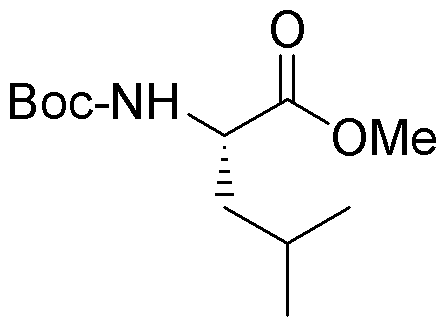Boc-L-leucine methyl ester is widely utilized in research focused on:
- Peptide Synthesis: This compound serves as a valuable building block in the synthesis of peptides, particularly in solid-phase peptide synthesis, where its protective group facilitates the assembly of amino acids.
- Drug Development: Its role in medicinal chemistry includes the development of peptide-based drugs, enhancing bioavailability and stability, which is crucial for therapeutic applications.
- Biotechnology: In biotechnological applications, it is used to modify proteins, aiding in the study of protein interactions and functions, which is essential for research in enzymology and molecular biology.
- Research in Neuroscience: The compound is employed in the synthesis of neuropeptides, contributing to research on neurological pathways and potential treatments for neurological disorders.
- Cosmetic Formulations: Its properties make it suitable for use in cosmetic formulations, where it can enhance the texture and stability of products, appealing to the beauty industry.
General Information
Properties
Safety and Regulations
Applications
Boc-L-leucine methyl ester is widely utilized in research focused on:
- Peptide Synthesis: This compound serves as a valuable building block in the synthesis of peptides, particularly in solid-phase peptide synthesis, where its protective group facilitates the assembly of amino acids.
- Drug Development: Its role in medicinal chemistry includes the development of peptide-based drugs, enhancing bioavailability and stability, which is crucial for therapeutic applications.
- Biotechnology: In biotechnological applications, it is used to modify proteins, aiding in the study of protein interactions and functions, which is essential for research in enzymology and molecular biology.
- Research in Neuroscience: The compound is employed in the synthesis of neuropeptides, contributing to research on neurological pathways and potential treatments for neurological disorders.
- Cosmetic Formulations: Its properties make it suitable for use in cosmetic formulations, where it can enhance the texture and stability of products, appealing to the beauty industry.
Documents
Safety Data Sheets (SDS)
The SDS provides comprehensive safety information on handling, storage, and disposal of the product.
Product Specification (PS)
The PS provides a comprehensive breakdown of the product’s properties, including chemical composition, physical state, purity, and storage requirements. It also details acceptable quality ranges and the product's intended applications.
Certificates of Analysis (COA)
Search for Certificates of Analysis (COA) by entering the products Lot Number. Lot and Batch Numbers can be found on a product’s label following the words ‘Lot’ or ‘Batch’.
Numéro de catalogue
Numéro de lot/série
Certificates Of Origin (COO)
This COO confirms the country where the product was manufactured, and also details the materials and components used in it and whether it is derived from natural, synthetic, or other specific sources. This certificate may be required for customs, trade, and regulatory compliance.
Numéro de catalogue
Numéro de lot/série
Safety Data Sheets (SDS)
The SDS provides comprehensive safety information on handling, storage, and disposal of the product.
DownloadProduct Specification (PS)
The PS provides a comprehensive breakdown of the product’s properties, including chemical composition, physical state, purity, and storage requirements. It also details acceptable quality ranges and the product's intended applications.
DownloadCertificates of Analysis (COA)
Search for Certificates of Analysis (COA) by entering the products Lot Number. Lot and Batch Numbers can be found on a product’s label following the words ‘Lot’ or ‘Batch’.
Numéro de catalogue
Numéro de lot/série
Certificates Of Origin (COO)
This COO confirms the country where the product was manufactured, and also details the materials and components used in it and whether it is derived from natural, synthetic, or other specific sources. This certificate may be required for customs, trade, and regulatory compliance.


